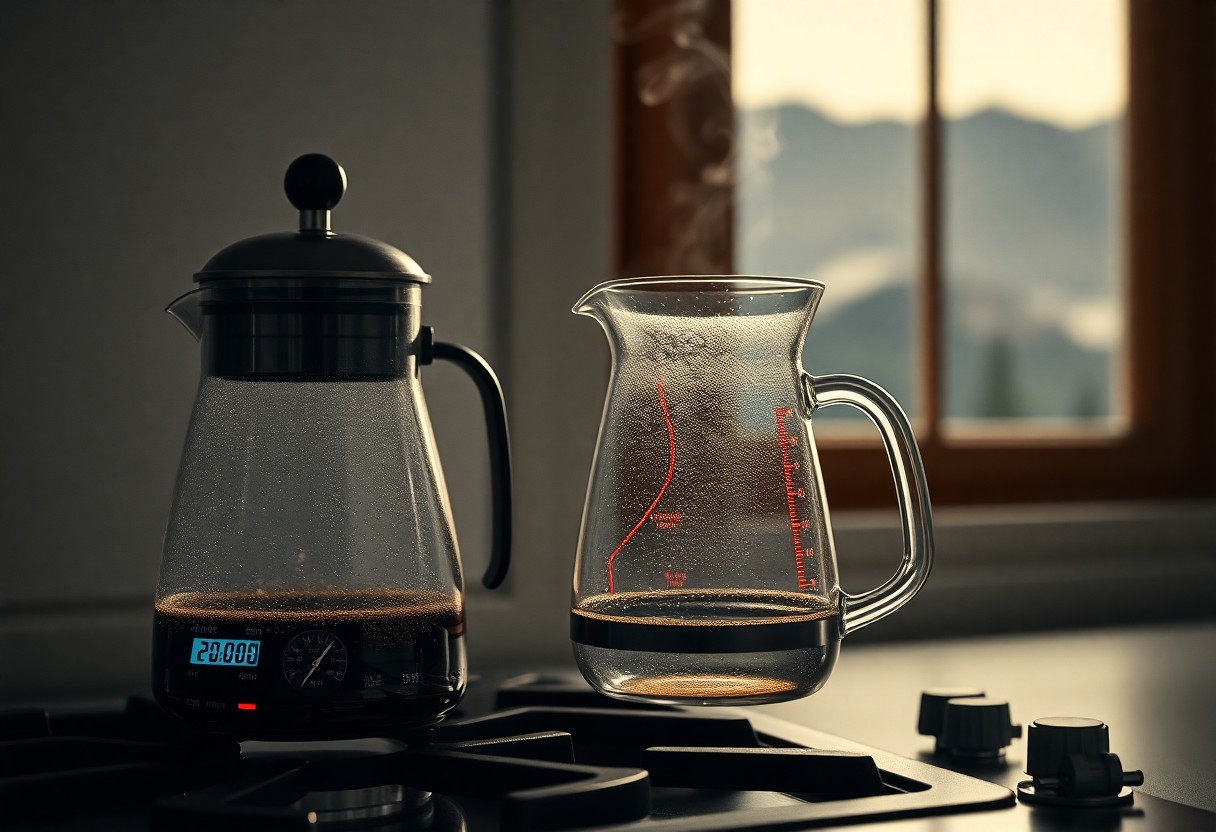Many coffee aficionados have likely noticed that their brew tastes different depending on where they are. Altitude significantly influences the brewing process, affecting factors like water temperature and extraction rates. As you ascend to higher elevations, the lower atmospheric pressure can alter the flavor profile of your morning cup, enhancing or dampening specific taste notes. Understanding these changes is vital for optimizing your coffee experience, ensuring that you savor the unique characteristics of your favorite beans, no matter where you find yourself sipping your brew.
Key Takeaways:
- As altitude increases, water boils at lower temperatures, which can affect the extraction process of coffee and lead to variations in flavor.
- High-altitude brewing can amplify certain flavor notes while diminishing others, often resulting in a brighter and more acidic coffee profile.
- Environmental factors such as air pressure and humidity at different altitudes can also influence the overall brewing technique and coffee experience.

The Science of Taste: Understanding Flavor Perception
Flavor perception is a complex interplay of taste, smell, and even texture. Your senses work together to create an experience that can vary significantly based on numerous factors, including environmental conditions. When evaluating how altitude impacts this perception, you not only need to consider taste buds but also the way your body reacts differently at higher elevations. These differences can completely transform how you experience your morning brew, making it important to understand the mechanisms at work.
The Role of Altitude in Human Physiology
As you ascend to higher altitudes, your body undergoes physiological changes to adapt to the decreased oxygen levels. This includes increased breathing rates and heart rate, which can lead to sensations of lightheadedness and fatigue. Such changes can also affect your taste and smell, as a drop in oxygen availability may alter how effectively your body registers different flavors. You might find your taste buds less sensitive, ultimately influencing how you enjoy your coffee.
How High Altitude Affects Taste Bud Function
Your taste buds are sensitive structures that react to various flavors, but their functionality can diminish at higher elevations. At around 8,000 feet or above, studies indicate that taste perception, especially for sweet and salty flavors, can decrease by up to 30%. This may lead you to unconsciously add more sugar or salt to your coffee than you would at sea level, altering your intended flavor profile. The decreased humidity and pressure can also play a role, affecting the way aromas reach your nose, which is integral to the overall taste experience.
When you’re at high altitudes, the combination of lower air pressure and humidity can lead to a muted sense of taste and smell. Research highlights that this can result in a blunted experience of flavors, particularly sweet and salty ones, making it necessary for you to adjust your brewing methods or ingredient proportions. This adaptation not only accounts for the environmental changes but highlights just how significant altitude is in shaping your sensory experience. The more extreme the elevation, the more your palate may crave enhanced flavor profiles, pushing you to explore more robust coffee options or brewing techniques like espresso or French press to compensate.

Brewing Variables: Water Temperature and Pressure at Altitude
| Variable | Impact at High Altitudes |
|---|---|
| Water Temperature | Boiling point decreases, resulting in lower extraction efficiency. |
| Pressure | Lower air pressure can lead to faster degassing of coffee compounds. |
Adjusting Brewing Parameters for Optimal Extraction
At higher elevations, you need to adjust your brewing parameters for optimal flavor extraction. Lower boiling temperatures mean that extending brew times or increasing the coffee-to-water ratio can compensate for diminished extraction. Experimenting with coarser grinds may also help, as this allows more surface area contact during the brewing process, yielding a fuller flavor profile even in lower water temperatures.
The Impact of Reduced Air Pressure on Brewing Techniques
Reduced air pressure influences not just extraction, but also the gases released during brewing. This lower pressure makes it easier for carbon dioxide trapped in the coffee grounds to escape, leading to a faster dissipation of flavor. You might notice that your coffee appears less aromatic and has a less vibrant flavor profile, unless you adapt your brewing technique accordingly.
When brewing at high altitudes, using methods that promote retention of carbonation can enhance flavor. Techniques like pour-over or immersion brewing can slow down the release of gases compared to methods that utilize pressure, like espresso machines. Additionally, adjusting the grind size and increasing contact time with water allows for more robust extraction and can create a more balanced cup, overcoming the challenges of reduced air pressure. Experimenting with these variables will enable you to consistently brew delicious coffee, even as altitude alters your ingredients’ chemistry.
Coffee Beans and Altitude: Variety and Quality
Altitude directly influences both the variety and quality of coffee beans. Beans grown at higher elevations tend to develop more complex flavors, as the cooler temperatures slow down their maturation process and allow for richer flavor compounds to form. The unique conditions at high altitudes, including warmer days and cooler nights, encourage beans to achieve optimal sweetness and acidity, resulting in a superior cup. As you explore the various regions across the globe, you’ll notice that high-elevation coffees often stand out for their quality and distinctive profiles.
Sourcing Beans from High Elevations: What Changes?
When sourcing beans from high elevations, you experience noticeable changes in flavor and quality. Typically, these beans carry enhanced acidity and a fuller body due to the gradual ripening process. Higher elevation coffee farms often utilize unique soil compositions and climatic conditions that foster the development of rich, vibrant taste notes, making these coffees truly distinctive. These subtle variations can significantly impact your morning cup, shifting basic expectations to a whole new level of enjoyment.
Distinct Flavor Profiles of High-Altitude Coffee Varieties
High-altitude coffee varieties offer distinct flavor profiles that can elevate your morning brew. Common tasting notes include bright acidity, floral undertones, and rich chocolatey flavors. The region’s terroir plays a vital role in shaping the taste, with specific heights and climates contributing to unique bean characteristics. You might find beans from regions like Colombia or Ethiopia exuding vibrant fruitiness, while others from Guatemala may present a more balanced, nutty profile. These complex taste combinations result from a combination of altitude, climate, and cultivation practices.
Delving deeper into the distinct flavor profiles of high-altitude coffee varieties, you will notice how specific regions produce signature tastes. For instance, Ethiopian coffees often reflect bright, citrusy notes with a tea-like finish thanks to their elevation and traditional processing methods. On the other hand, Colombian coffees might boast a syrupy sweetness with caramel and chocolate hints, achieved through meticulous cultivation at high elevations. Beans like these not only highlight the unique growing conditions but also showcase the diversity of flavors available, offering you a rich tapestry of taste to explore in every cup.
Practical Tips for Brewing at Elevated Altitudes
Brewing coffee at high elevations requires some adjustments to your method for optimal results. Consider these practical tips to enhance your experience:
- Increase brewing time slightly to compensate for faster extraction
- Lower the grind size for improved flavor concentration
- Use a thermometer to ensure water temperature is between 195°F to 205°F
- Experiment with different coffee ratios for better taste
The right adjustments can transform your morning brew even at higher altitudes.
Techniques to Enhance Flavor in Your Morning Brew
To boost the flavor of your coffee at altitude, consider employing varied extraction methods. For example, methods like French press or pour-over can enhance the coffee oils and flavors, resulting in a richer cup. Adjust the water temperature while brewing, as slightly cooler water can prolong extraction time, leading to a more balanced flavor profile. You might also experiment with different brewing methods to discover which you prefer. Small tweaks can yield significant improvements, ensuring your brew has depth and complexity.
Equipment Recommendations for High-Altitude Brewing
For effective brewing at high altitudes, specific equipment can make a notable difference. Opt for a coffee grinder with a conical burr mechanism, as this allows for precise control over grind size, important for achieving the right extraction balance. A reliable thermal coffee carafe will help maintain heat without condensation, keeping your brew hot longer. Additionally, investing in a quality water kettle that allows for temperature control can significantly enhance your overall brewing experience.
Considering your brewing equipment is fundamental when facing the unique challenges of high-altitude coffee preparation. A conical burr grinder is particularly beneficial for achieving consistency in size, which impacts extraction rates. A temperature-controlled kettle provides precision that allows you to experiment with temperatures tailored to your desired coffee profile. A thermal carafe or insulated French press can maintain your brew’s temperature longer, which is important since cooler temperatures can alter flavor perception. Together, these tools will empower you to enjoy a delightful cup, crafted to perfection.
The Cultural Impact of Altitude on Coffee Consumption
Local cultures and traditions significantly shape your coffee experience and appreciation, especially at varying altitudes. As you explore high-altitude regions, unique brewing methods, flavor preferences, and social rituals associated with coffee consumption emerge, showcasing how elevation influences not just what you drink, but also how you enjoy it. Each location adds its own flair, inviting you to participate in a rich tapestry of customs that entwine coffee with community life.
Regional Preferences and Brewing Traditions
Your coffee ritual often varies greatly based on your region. In Colombia’s mountainous areas, for instance, you might savor a rich, dark roast brewed using a traditional “tinto” method, reflecting local tastes developed at high altitude. Meanwhile, you may find lighter brews with fruity notes more prevalent in Ethiopian highlands, emphasizing the diverse nature of coffee traditions shaped by geography.
How Local Elevation Influences Coffee Culture
Specific elevation levels play a pivotal role in cultivating distinct coffee cultures. In regions like Guatemala, the extreme altitude directly contributes to the production of some of the world’s most famous beans, fostering a culture that celebrates coffee from farm to cup. The local population develops traditional brewing practices and social gatherings around coffee that enhances not only flavor but also community connections.
In high-altitude areas, the appreciation for coffee is often deeply intertwined with local lifestyle and geography. For example, coffee farmers typically live and work in the same mountainous regions where their beans grow, creating a unique bond with the land. This proximity leads to an intricate understanding of how altitude affects flavors, resulting in celebrated brewing techniques passed down through generations. You may even find coffee festivals that celebrate not only the harvest but also the culture that revolves around coffee, illustrating how elevation enriches your coffee experience on multiple levels.
Summing up
Upon reflecting, it becomes clear that altitude significantly impacts your morning brew, altering not only the extraction process but also the overall flavor profile. Higher elevations lead to a quicker brewing time due to lower air pressure, which can mean a lighter, more vibrant cup if optimized correctly. Understanding how these factors play into your coffee experience allows you to adapt your brewing methods to suit your location and preference, potentially elevating your daily ritual to new heights.
FAQ
Q: How does altitude affect the brewing temperature of coffee?
A: At higher altitudes, the boiling point of water decreases due to lower atmospheric pressure. For instance, water boils at about 92°C (198°F) at 1,500 meters (5,000 feet) instead of the standard 100°C (212°F) at sea level. This lower brewing temperature can result in under-extraction, leading to a sour or weak taste in your coffee. To compensate, it may be necessary to extend the brewing time or adjust the coffee-to-water ratio to achieve optimal flavor extraction.
Q: Why do coffee beans taste different at high altitudes?
A: Coffee beans grown at higher altitudes often develop more complex flavors due to slower maturation processes. Cooler temperatures slow down the ripening of coffee cherries, allowing more sugars and acids to develop. These factors contribute to a brighter acidity and a richer flavor profile. Therefore, coffee brewed from beans sourced from high-altitude regions may exhibit distinct notes that are more pronounced compared to beans grown at lower elevations.
Q: How does pressure at high altitudes influence coffee extraction?
A: As altitude increases, atmospheric pressure decreases, which can impact the extraction process of soluble compounds from coffee grounds. Since the brewing process relies on pressure to extract flavors and oils, lower pressure can lead to a less efficient extraction. This might cause an imbalance in flavor, often resulting in a cup that lacks depth and complexity. Adjusting brewing methods or equipment, such as using a French press or AeroPress, can help optimize extraction even at higher altitudes.
Q: Can altitude affect the grind size of the coffee beans?
A: Yes, altitude can influence the ideal grind size for coffee preparation. At higher altitudes, the reduced pressure may require a finer grind to achieve better extraction, especially if using methods like espresso. A finer grind increases the surface area, allowing for enhanced flavor extraction at the lower brewing temperatures typically found at these elevations. Experimenting with grind size can help you find the perfect balance to enjoy a flavorful cup of coffee.
Q: Are there specific brewing methods recommended for high-altitude coffee?
A: For high-altitude coffee brewing, certain methods are particularly effective. Sous-vide, pour-over, and cold brew techniques tend to work well, as they allow for greater control over water temperature and brewing time. Additionally, manual brewing methods like the Chemex or V60 can help achieve consistent results by allowing the brewer to adjust pouring techniques and water flow. Experimentation with these methods can lead to more satisfying taste outcomes in your morning brew.
